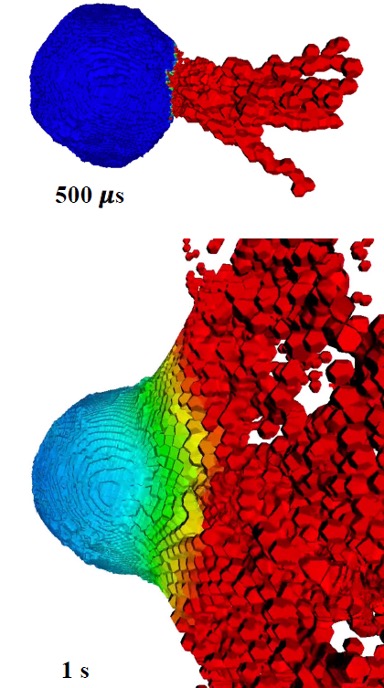Lawrence Livermore takes part in international planetary defense conference
 (Download Image)
(Download Image)
Simulations of NASA’s DART spacecraft, which will crash into asteroid Dimorphos in fall 2022, show the differences between modeling the full spacecraft geometry and a spherical approximation of the spacecraft. Credit: Mike Owen, Spheral ASPH code.
Ten scientists from Lawrence Livermore National Laboratory (LLNL) last week took part in the 7th IAA Planetary Defense Conference (PDC), hosted by the United Nations Office for Outer Space Affairs in cooperation with the European Space Agency.
Megan Bruck Syal, who helped lead the Lab’s participation in the event and who also was a conference session chair, said this year’s conference was planned to occur at the United Nations Office at Vienna, Austria. Due to the pandemic the conference went into a fully virtual mode, but was still held on Vienna time, which meant very early mornings for the LLNL team.
“Every other year, PDC brings together an international group of experts on technical and policy issues surrounding the defense of Earth from hazardous asteroids and comets,” she said. “We know that currently, the U.S. has many knowledge and capability gaps for planetary defense readiness. The work we are doing today, and the opportunity to discuss that work with the broader international community at venues like PDC, is helping to close these gaps.”
A central component of every PDC is a Hypothetical Asteroid Impact Scenario, which simulates the high-stakes technical questions and decision-making that would be necessary in the face of evolving information about a real asteroid threat.
“As subject matter experts on nuclear and kinetic deflection techniques, LLNL scientists always play an important role in how these exercises unfold,” she said. “This year was no different, as the very short warning time for the Hypothetical Asteroid 2021 PDC meant that only a nuclear disruption mission could successfully prevent Earth impact.”
In the event that such an impact is unpreventable, LLNL scientists also conduct consequence assessment calculations, quantifying the damage from low-altitude airbursts and surface impacts. This is key for advising emergency response measures.
LLNL participants presented on wide range of topics
New approaches for X-ray energy deposition modeling, using the Kull hydrocode, are being used to initialize nuclear deflection and disruption calculations, such as the one shown here. This 120-meter asteroid is fragmented into many well-dispersed pieces by a one-megaton burst, applied nine meters off the surface. Credit: Mary Burkey, Spheral ASPH code.
See the video detailing the above X-ray energy deposition modeling.
This year, the Lab’s team presented advances in X-ray energy deposition and re-radiation modeling, which is essential for accurate nuclear deflection and disruption calculations. Team members also presented on preparations for NASA’s Double Asteroid Redirection Test (DART) Mission, including the effects of modeling the DART spacecraft’s detailed geometry in its high-speed impact with asteroid Dimorphos, planned for fall 2022.
New machine learning approaches for multiphysics simulations, which will be important for full interpretation of the data received from the DART experiment, also were presented by the LLNL team. Advances in airburst modeling, using the Adaptive Smoothed Particle Hydrodynamics (ASPH) code Spheral, also were presented.
LLNL presenters included:
- Nick Gentile, “An Overview of Numerical Radiation Transport Techniques in Asteroid Deflection Modeling”
- Mary Burkey, “Progress on Developing a Simplified Model of X-Ray Energy Deposition for Nuclear Mitigation Missions”
- Cody Raskin, “Accelerated Root Finding for the DART Inverse Test Using Machine Learning Decision Trees”
- Mike Owen, “Spacecraft Geometry Effects on Cratering and Deflection in the DART Mission”
- Jason Pearl, “SPH Simulation of Atmospheric Effects on Bolide Entry”
Deflection & Disruption Testing - ePosters:
- Timmy Chang (HEDP summer student), “Hydrodynamic Simulation of the Explosively Formed Projectile for Crater Formation on the Asteroid Ryugu from Hayabusa2”
- Lansing Horan (HEDP summer student), “Neutron Energy Effects on Asteroid Deflection”
- Kirsten Howley, “X-rays, Neutrons, Gammas, Oh My: Why Simulating Asteroid Deflection Using a Nuclear Device Is Hard”
- Rob Managan, “NEO Deflection Formulae”
Contact
 Michael Padilla
Michael Padilla
[email protected]
(925) 341-8692
Related Links
IAA Planetary Defense ConferenceTags
HPC, Simulation, and Data ScienceComputing
Engineering
Global Security
Lasers and Optical S&T
Lasers
National Ignition Facility and Photon Science
Physical and Life Sciences
Science
Featured Articles








